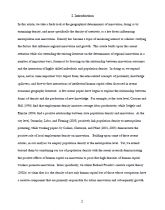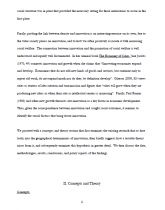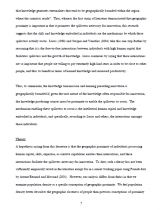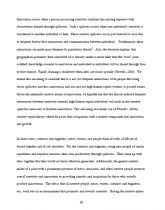Hledej
Zobraz:
Univerzity
Kategorie
Rozšířené vyhledávání
12 659 projektů
0 nových
Beyond spillovers: The effects of creative-density on innovation
| Přípona |
Typ projekt |
Stažené 0 x |
| Velikost 0,6 MB |
Jazyk anglický |
ID projektu 2894 |
| Poslední úprava 27.03.2014 |
Zobrazeno 866 x |
Autor: eliseus |
 Sdílej na Facebooku
Sdílej na Facebooku |
||
| Detaily projektu | ||
- Cena:
2 Kreditů - kvalita:
86,9% -
Stáhni
- Přidej na srovnání
- Univerzita:Univerzita Tomáše Bati ve Zlíně
- Fakulta:Fakulta managementu a ekonomiky
- Kategorie:Ekonomika » Management
- Předmět:Management
- Studijní obor:-
- Ročník:-
- Formát:PDF dokument (.pdf)
- Rozsah A4:38 stran
In this article, we take a fresh look at the geographical determinants of innovation, doing so by
examining density, and more specifically the density of creativity, as a key factor influencing
metropolitan area innovation. Density has become a topic of increasing interest to scholars studying
the factors that influence regional innovation and growth. This article builds upon this recent
attention while also extending the existing literature on the determinants of regional innovation in a
number of important ways, foremost by focusing on the relationship between innovation outcomes
and the interaction of highly skilled individuals and population density. In doing so, we expand
upon, and in some important ways depart from, the inter-related concepts of proximity, knowledge
spillovers, and face-to-face interactions of intellectual human capital often discussed in recent
economic geography literature. A few recent papers have begun to explore the relationship between
forms of density and the production of new knowledge. For example, at the state level, Ciccone and
Hall (1996) find that employment density increases average labor productivity, while Sedgely and
Elmslie (2004) find a positive relationship between state population density and innovation.
examining density, and more specifically the density of creativity, as a key factor influencing
metropolitan area innovation. Density has become a topic of increasing interest to scholars studying
the factors that influence regional innovation and growth. This article builds upon this recent
attention while also extending the existing literature on the determinants of regional innovation in a
number of important ways, foremost by focusing on the relationship between innovation outcomes
and the interaction of highly skilled individuals and population density. In doing so, we expand
upon, and in some important ways depart from, the inter-related concepts of proximity, knowledge
spillovers, and face-to-face interactions of intellectual human capital often discussed in recent
economic geography literature. A few recent papers have begun to explore the relationship between
forms of density and the production of new knowledge. For example, at the state level, Ciccone and
Hall (1996) find that employment density increases average labor productivity, while Sedgely and
Elmslie (2004) find a positive relationship between state population density and innovation.
Klíčová slova:
innovation
city
determinant
density
creativity
Obsah:
- I. Introduction
II. Concepts and Theory
III. Data and Methods
IV. Findings
V. Conclusions
References
Zdroje:
- Audretsch, D., and Feldman, M. 1996. R&D Spillovers and the Geography of Innovation and
- Production. The American Economic Review 86:630-640.
- Autant-Berard, C., and Massard, N. 2001. Scientific interactions, geographic spillovers and
- innovation: An empirical study on the French case. Working paper, CREUSET, University
- Jean Monnet Saint Ettienne.
- Black, D.; Gates, G.; Sanders, S.; and Taylor, L. 2000. Demographics of the Gay and Lesbian
- Population in the United States: Evidence from Available Systematic Data Sources.
- Demography 37:139-154.
- Carlino, G.; Chaterjee, S.; and Hunt, R. 2001. Knowledge Spillovers and the New Economy of
- Cities. Working Paper No. 01-14, Federal Reserve Bank of Philadelphia.
- ------. 2005. Matching and Learning in Cities: Urban Density and the Rate of Invention. Working
- Paper No. 04-16/R, Federal Reserve Bank of Philadelphia.
- Ciccone, A., and Hall, R. 1996. Productivity and the Density of Economic Activity. The
- American Economic Review 86:54-70.
- Cohen, W., and Levinthal, D. 1994. Fortune Favors the Prepared Firm. Management Science 40:227-
- 251.
- Desrochers, P. 2001. Local Diversity, Human Creativity, and Technological Innovation. Growth and
- Change 32:369-394.
- DeVol, R.; Wong, P.; Catapano, J.; and Robitshek, G. 2001. America’s High-Tech Economy;
- Growth, Development, and Risks for Metropolitan Areas. Milken Institute.
- El Nasser, H., and Overberg, P. 2001. “A Comprehensive Look at Sprawl in America.” USA Today,
- 22 February.
- Feldman, M. 2000. Location and Innovation: The New Economic Geography of Innovation,
- Spillovers, and Agglomeration. In The Oxford Handbook of Economic Geography, eds. G. Clark,
- M. Gertler, and M. Feldman, 373-394. Oxford,UK: Oxford University Press.
- Florida, R. 2000. Competing in the Age of Talent: Quality of Place and the New Economy. Report
- to the Richard King Mellon Foundation, Pittsburgh Pa.
- ------. 2002a. The Economic Geography of Talent. Annals of the Association of American Geographers
- 92:743-755.
- ------. 2002b. Bohemia and Economic Geography. The Journal of Economic Geography 2:55-71.
- ------. 2002c. The Rise of the Creative Class. New York, NY: Basic Books.
- Florida, R., and Gates, G. 2001. Technology and Tolerance: The Importance of Diversity to High-



